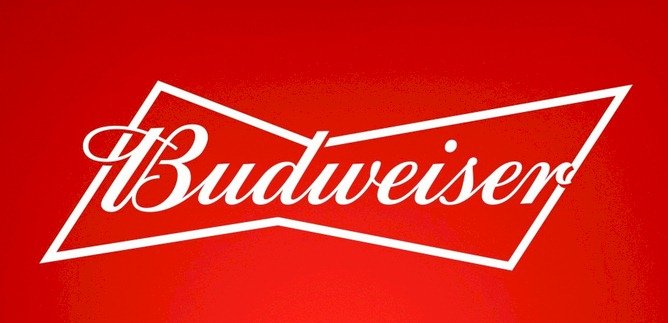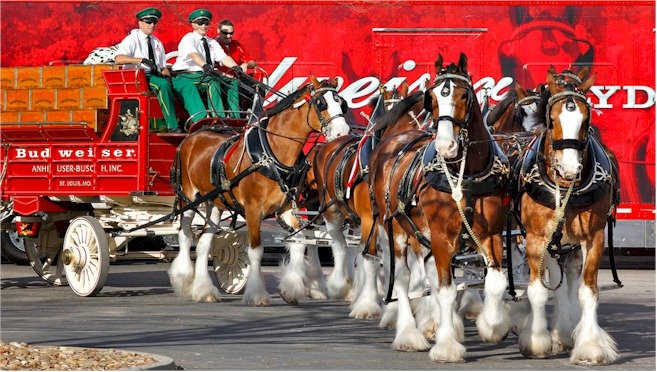A look at the Budweiser Logo and the History of Anheuser–Busch.
Since the late 1880s, Anheuser–Busch – the parent company of Budweiser – has dominated the beer industry. In 2016 alone, the company generated 45.52 billion dollars in revenue. While the affordability and great taste of their beverages have played an enormous role in its success, so has their marketing and branding endeavors. In this article, we’ll take a look at Budweiser’s lustrous history, the origins of the Budweiser logo, and how it has helped propel them to the level of success the company has come to enjoy.
This is the evolution of the Budweiser logo. Since the first logo in 1876, it has changed around 15 times. It went from a complicated design to a more fun and friendly design in 1963, to something a little more simple in 1968. The new, current logo is simple and clean, easy on the eyes, and great for branding.

Origin of Budweiser In 1852, a German saloon operator and brewer named George Schneider opened a brewery in South St. Louis called the Bavarian Brewery. Schneider would go on to expand to a second location in St. Louis; however, in 1857, Schneider’s breweries would undergo financial hardships. On the brink of bankruptcy, Schneider was forced to sell his brewery to various owners. In 1860, the brewery was purchased by William D’Oench and Eberhard Anheuser, and by 1869 Anheuser was the brewery’s sole owner. Shortly after that, though, Anheuser sold 50% of the company to a salesman in the company named Adolphus Busch, and the company was renamed Anheuser–Busch.
Busch would quickly go on to revolutionize the beer market in America. He became the first
American to pasteurize beer, developed a refrigerated car company to expand its
delivery capabilities and produced a great tasting beer that became the first national beer brand in the US. He named this beer Budweiser.
From the 1880s to the 1890s, Busch executed an aggressive marketing campaign, sending out free bottle openers, corkscrews, pocket knives, calendars, and more to promote his brand. The campaign was successful, and Anheuser–Busch had to quickly expand to keep up with their Budweiser beer demand.

Everything was going great for Anheuser–Busch until prohibition began. For prohibition from the 1910s to the 1930s, Anheuser–Busch struggled to stay afloat. To survive, the company started selling ice-cream, brewer’s yeast, and non-alcoholic beer to survive. Somehow, the company was able to ride out prohibition, putting themselves in a position to launch right back into regular operation when prohibition ended.
In the years that followed, Anheuser–Busch would go on to open breweries across the world and several theme parks. Today, Anheuser–Busch continues to execute an aggressive
advertising strategy, sponsoring everything from horse races, NASCAR, and even Superbowl ads. Of course, one key element of this advertising success from the early days to the present has been the recognizable Budweiser logo.
Looking For a Logo Designer?
Thousands of businesses have trusted LogoMyWay with their logo design. We have thousands of logo designers ready to work on your new logo.
History of the Budweiser Logo Over the years, the Budweiser logo has undergone several iterations. However, for the most part, the logo has kept the same key elements of the company’s first logo, which was released in 1924. Though the current Budweiser logo looks more crisp and modern than previous designs, it is still comparable to all the logos that preceded it. This consistency in design has played an essential role in helping Budweiser retain its status and recognizability from generation to generation and has been an essential part of its marketing.
The Budweiser Logo Design Elements
One of Budweiser’s key slogans is “The King of Beers,” which is an idea that the Budweiser logo conveys by featuring a gold crown on the top of the label. Meanwhile, the bow-tie design of the logo conveys a sense of sophistication and elegance.
The Budweiser logo colors feature a bright red, a crisp white, and tinges of gold. The bright red color allows the logo to be easily noticed and recognized from a distance. Studies have also shown that the color red causes a person’s appetite to be stimulated, which plays to the advantage of Budweiser. Meanwhile, white conveys an idea of purity and cleanliness, and the tinge of gold plays into Budweiser’s image of sophistication and royalty.
Together, the red and white colors combine to convey a sense of American heritage and patriotism – something Budweiser has long used in the themes for their marketing campaigns.
Lastly, the Budweiser logo features a font designed specifically for the company, helping Budweiser further cement its logo’s uniqueness and branding. Any company that leverages advertising as much as Anheuser–Busch will have to rely on its logo to make those advertising efforts successful.
It was never enough for Budweiser to simply market the merits of their beer. Instead, they had to create a message behind it, an identity for their brand, and an association in their customers’ minds. Even today, if you look at most Budweiser commercials, you will see that the Budweiser brand’s key elements, such as their Clydesdale horses and their recognizable logo, play the primary role in the ad. Budweiser doesn’t necessarily try to spend their commercial slots telling you how great Budweiser beer tastes or how affordable it is. Instead, they create an ad that is humorous or touching somehow, then feature their logo throughout the commercial and prominently feature it at the commercial’s end.
Through this type of advertising, Budweiser has saturated the market with images of their logo. When Budweiser runs an ad, it isn’t their intention that a person viewing the ad will immediately go out and purchase a Budweiser beer. Instead, their goal is to create positive associations and recognizably so that the next time they are at a bar or at a store, Budweiser is the first thing that comes to mind.
In this way, the recognizability of the Budweiser logo and the themes that it represents have
played an enormous role in helping the beer become one of the most popular brands in the
The United States. If a company can create a great, recognizable logo and build a theme and association around that logo, such as what Anheuser–Busch has done, success is sure to follow.










